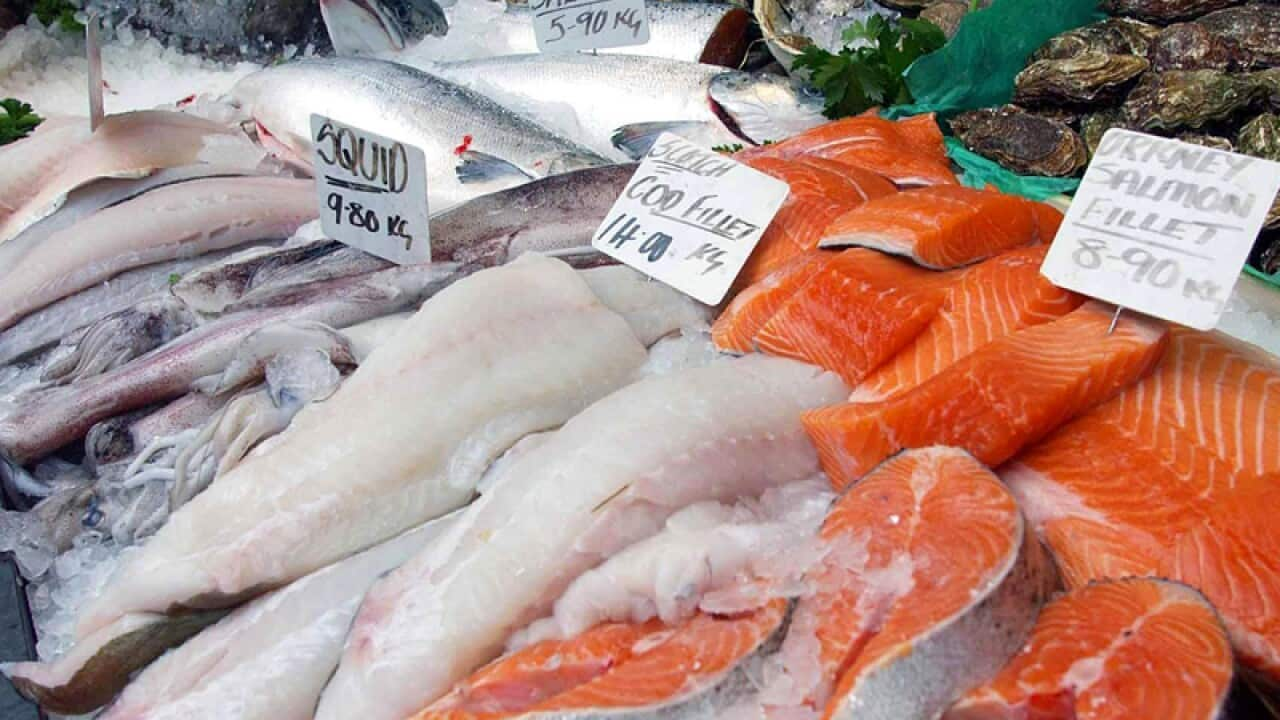Australians are often taken aback to discover that we import about 75 per cent of the seafood we consume. Yes, that’s right – in a nation girt by sea that vaunts its love of a shrimp on the barbie, three-quarters of our fish and shellfish comes from overseas.
Wander over to your local supermarket and look at the seafood on offer. Barramundi, the iconic Australian fish, is usually there but it is often from Vietnam, having been farmed and frozen. The processed products – crumbed prawns or garlic prawns – are also usually from Asia, and bright yellow-dyed smoked cod is seemingly always from South Africa.
Then there are the truly “glocal” (local-global) items, such as crumbed products made using Australian fish that has been sent to Thailand for processing and then shipped back again. This type of practice is set to become more common, as the family-owned Australian seafood company Kailis Bros this year sold 90 per cent of its seafood processing, wholesale and export business to a Chinese conglomerate.
Eating ‘glocal’?
As anyone who has a passing acquaintance with contemporary food politics knows, it’s all about eating local, seasonal and sustainable produce. As previous writers on The Conversation have pointed out, food choices have become loaded with moralism, which can make choosing the “right” food somewhat daunting.
Our research – including Elspeth’s forthcoming book, Eating the Ocean, and Kate’s soon-to-be-submitted PhD thesis on sustainable tuna – shows these problems become even trickier when it comes to fish.
Beyond the obvious problem of trying to eat local when talking about food that comes from a vast ocean, there is the added problem of the way in which fishing has developed as a globalised industry.
Over the past 20 years the ownership of fishing boats in the Global North (including Australia) has shrunk to a fraction of what it was. This has been part of a necessary move to regulate international fishing practices and ensure all countries have access to a fair share.
But the quotas introduced in Iceland, Canada, and Australia in the late 1970s and early 1980s have also had the effect of concentrating ownership of the fishing industry in relatively few hands. In South Australia, for example, the number of licensed bluefin tuna fishers went from several hundred to fewer than 30.
Meanwhile, the downturn in inshore fishing because of overfishing, and the need to cover the costs of increasingly sophisticated technology to track fish, has led to ever-larger boats that can work farther from shore.
Simply put, this means you can no longer go down to the dock and look the fisherman "in the eye” as the US writer Michael Pollan has urged us to do for land-based farming. Long fishing trips means that fish have to be caught in vast numbers, flash-frozen while still at sea, then landed and immediately transferred to huge logistical operations covering hundreds or thousands of kilometres.
There are other reasons why Australia, despite having the world’s third-largest Exclusive Economic Zone, consumes so much imported fish. Our seas evidently suffer from low productivity and scarce nutrients. But no matter: the government reassures us that high seafood imports are common in wealthy nations.
One answer might be to catch your own, but be careful where you try, especially in urban areas. UNSW Australia’s Emma Johnston has described how Sydney’s stormwater overflows, combined with a history of industrial dumping, have rendered its harbour a toxic slurry – so it’s better not to eat any fish caught under the bridge.
Fish going in all directions
The flow of fish goes both ways, or rather multiple ways. Australia exports high-value fish and seafood around the world. Our lobsters and abalone are loved in China, while nearly all of South Australia’s bluefin tuna goes to Tokyo’s famous Tsukiji fish market.
The tuna barons in Port Lincoln, SA, a town that used to boast Australia’s highest number of millionaires per capita, have become experts in international currency. Their fish, fattened in pens and inspected by visiting connoisseur Japanese investors, are priced in yen – and the farmers listen carefully to the visitors' advice, knowing that a good product is worth even more yen.
Back in the supermarket, there’s evidence that consumers are willing to spend time thinking about tuna too – at least, if Kate’s collection of dozens of eco-labelled tuna cans is any guide. Unlike the Japanese market, where the quality of the flesh is paramount, the supermarket labels suggest ecological sustainability is the key consideration. But sustainability goes deeper than just the fish itself; we rarely think about how sustainable the can is, nor about how the metal was mined, nor about the transport costs for the fish or packaging.
Does it matter that we eat so much of other nations' fish, while sending our most prized delicacies to foreign buyers? The answers vary: some people worry about reports of illegal fishing practices and pollution in Southeast Asia, where some fish are still caught using cyanide.
Equally chilling are the reports of “sea-slaves” – indentured labourers from Cambodia and Myanmar who are forced to work in the Thai shrimp trade.
On the other hand, would we want to stop our fishers, who by and large work in a highly regulated, sustainable enterprise, from getting top dollar for their produce? It is a tough call, and an even tougher set of complex relations.
What’s certain is that guilt-tripping consumers into buying local doesn’t even begin to scratch the surface of the ethics of eating the ocean.
Elspeth Probyn is Professor of Gender & Cultural Studies, University of Sydney; Kate Johnston is a PhD candidate in Cultural Studies, University of Sydney.
Share
SBS Food is a 24/7 foodie channel for all Australians, with a focus on simple, authentic and everyday food inspiration from cultures everywhere. NSW stream only. Read more about SBS Food
Have a story or comment? Contact Us




